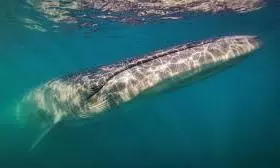
Majestic sei whales make a remarkable return to Argentine waters
text_fieldsAfter an absence of more than a century, the majestic sei whales have reappeared in the waters off Argentina's Patagonian coast.
Once on the brink of extinction due to relentless hunting during the 1920s and 1930s, these giant blue-grey creatures have made a remarkable comeback. Decimated by whaling ships operating along Argentina's shores, the sei whale population vanished from the region. However, global bans on commercial whaling enforced in recent decades have paved the way for their return.
Biologist and marine ecosystem researcher Mariano Coscarella of Argentina's CONICET scientific agency explained that the sei whales disappeared due to hunting. "They did not become extinct but were so reduced that no one saw them," he said. "After nearly a century of being hunted to near extinction, sei whale populations are now bouncing back and returning to their former habitats," he added.
It has taken decades for sei whale numbers to rebound sufficiently for sightings to occur again. Coscarella noted that it took over 80 years in this case. These whales reproduce every two or three years, so it nearly took 100 years for their population to reach a level where people could notice their presence.
Sei whales, belonging to the baleen whale family, are characterized by their sleek, streamlined bodies, typically bluish-grey in color. Known for their distinctive tall, curved dorsal fin and relatively small, pointed flippers, they can reach lengths of up to 62-66 feet and weigh up to 28-45 metric tons. Feeding on small fish and plankton by filtering water through their baleen plates, sei whales play a vital role in marine ecosystems.
Argentina's CONICET team recently fitted some sei whales with satellite trackers to monitor their migration patterns, a project funded by National Geographic's Pristine Seas project. Valuable footage of the whales in action was gathered via drones and underwater recordings.
Coscarella hailed this as "a success of conservation on a global scale," attributing the recovery to the worldwide ban on whaling.











